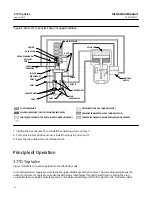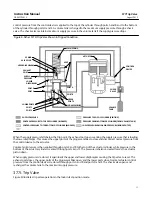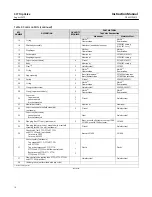
Instruction Manual
D200319X012
377 Trip Valve
August 2012
8
WARNING
Personal injury or property damage could result from bursting of parts due to temperature fluctuations or extreme heat. If
temperature fluctuations or extreme heat cannot be avoided, use a relief valve to protect the volume tank.
4. Read the following information before making pressure connections:
a. Trip valve port A must receive the operating pressure that is intended for the top of the actuator cylinder.
Depending on the actuator type and accessories being used, this operating pressure will be from a valve
positioner or switching solenoid.
b. Trip valve port B must provide operating pressure to the top of the actuator cylinder. Depending on the actuator
type and accessories being used, connect this port to the manifold assembly, to the top of the cylinder, or to the
cylinder connection on the hydraulic snubber (if one is used).
c. Trip valve port C must provide a fail‐mode outlet for the operating pressure to or from the top of the actuator
cylinder. For the fail‐down mode, connect this port to the volume tank. For the fail‐up mode, vent this port to
atmosphere. For the lock‐in‐last‐position mode, plug this port.
d. Trip valve port D must receive the operating pressure that is intended for the bottom of the actuator cylinder.
Depending on the actuator type and accessories being used, this operating pressure will be from a valve
positioner or switching solenoid.
e. Trip valve port E must provide operating pressure to the bottom of the actuator cylinder. Always connect this
port to the bottom of the actuator cylinder.
f. Trip valve port F must provide a fail‐mode outlet for the operating pressure to or from the bottom of the actuator
cylinder. For the fail‐down mode, vent this port to atmosphere. For the fail‐up mode, connect this port to the
volume tank. For the lock‐in‐last‐position mode, plug this port.
Operating Information
Calibration
This calibration procedure assumes that the trip valve is mounted on the actuator (or other device) and that all piping
and the appropriate volume tank (if necessary ) are installed. All key numbers refer to figure 10. For the appropriate
fail‐mode schematic, see figure 7, 8, or 9.
WARNING
The following procedure requires taking the trip valve out of service. To avoid personal injury and property damage by an
uncontrolled process medium, provide some temporary means of control of the process medium while the trip valve is out
of service.
1. Remove the adjusting screw cap (key 1).
2. Loosen the hex nut (key 3), and turn the set screw (key 2) counterclockwise until all loading is removed from the
spring (key 6).




















